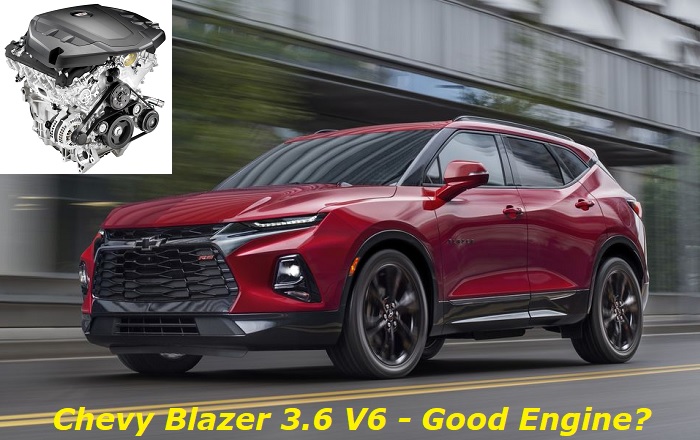The 2021 Chevrolet Blazer is a mid-size SUV powered by choices of three engines. The five-seat vehicle comes equipped with either a front or all-wheel-drive drivetrain. The base engine is a 2.5-liter four-cylinder with 193 horsepower, followed by a turbocharged 2.0-liter four-cylinder that produces 227 horsepower.
At the top is an optional 3.6-liter V6 engine with a respectable output of 308 horsepower - the three engines pair with a nine-speed automatic transmission. While the other two engines are excellent, our focus today is on the Chevrolet Blazer 3.6L V6 LGX engine.
Dive in as we explore the features, specs, possible lifespan, and a few known issues associated with the V6.

Key features and my opinion about the engine
- Production years:2015-now
- Average lifespan of LGX:190,000-230,000 miles
- Fuel supply type:direct injection
- Power range:310-335 hp
- Fuel efficiency:bad
- Engine block material:aluminum
- Engine reliability score:medium
- The most common problems:thermostat problems, start-stop is glitchy, weak sensors, enormous fuel consumption in the city traffic.
Chevy Blazer's 3.6L V6
As mentioned earlier, the Blazer comes with three engine options. And the most powerful is the 308-horsepower 3.6-liter V6. It is a naturally-aspirated six-cylinder built by General Motors to use on a wide range of vehicles.
With a production code LGX, the V6 is part of General Motors' fourth generation high-feature dual overhead camshaft V6 engine lineup launched in 2016. The first vehicles to utilize the 3.6 Liter V6 LGX powertrain were the 2016 Cadillac ATS, CTS, and CT6, before the engine made its way to other GM vehicles such as the 2021 Chevrolet Blazer.
The GM 3.6 Liter V6 LGX engine is a clean sheet design, and it shares little to nothing with the engine it replaced, the 3.6L six-cylinder LFX. The LGX sets the bar for powertrain refinement, efficiency, and durability.
Chevrolet Blazer 3.6L V6 Engine Features and Specifications
One of the greatest plus points of the 3.6-liter V6 LGX is the design. It is engineered to be an industry leader in performance and efficiency. Its refinement also makes the Chevrolet Blazer one of the smoothest vehicles. The V6 is built to be the benchmark for all naturally-aspirated six-cylinder engines and perfectly augments the Blazer's standards for sophistication.
GM built the 3.6-liter V6 LGX engine on the established strengths of its previous motors, pushing the technologies to higher levels, and bringing new ones on board to enhance the motor's refinement. As a result, the performance and fuel efficiency of the engine were pushed to benchmark levels.
The Chevrolet Blazer 3.6-liter V6 engine is perfectly engineered to deliver peak performance, industry-leading refinement, and efficiency with maximum durability. And it does these with minimal maintenance. These attributes place the 2021 Chevrolet Blazer at the forefront of any luxury vehicle powered by a naturally-aspirated V6 engine.
5 Features That Make the Chevrolet Blazer 3.6L V6 an Excellent Engine
- Clean-Sheet Design
The Chevy Blazer, as mentioned earlier, is powered by the GM 3.6 Liter V6 LGX, a clean-sheet engine design that shares little to no features with its predecessor. The all-new design, therefore, means that the Chevrolet Blazer V6 engine was perfectly engineered to set the benchmark for performance and efficiency. The LGX is a part of GM's fourth-generation V6 engine lineup that sets the bar for refinement and durability.
- Active Fuel-Saving Technologies
The 3.6-liter V6 LGX is one of the best engines of its size when it comes to fuel efficiency. It features Active Fuel Management and start-stop technologies designed to minimize fuel consumption. During light-load driving, the Active Fuel Management system temporarily deactivates two of the engine's cylinders, number two and five, to reduce fuel consumption. The two cylinders smoothly come back to life whenever the driver needs a full power supply.
The start-stop technology enhances the engine's efficiency by shutting it down in slow movement and stop-and-go driving on city streets. This reduces fuel consumption. The motor switches off when the driver stops and reignites automatically when the driver lifts their feet from the brake pedal.
- Stronger Foundation
All previous GM V6 engines have potent and quiet foundations. The LGX is structurally similar to those engines, including the aluminum deep-skirt cylinder block. The motor features an optimal 60-degree cylinder angle with a bore size of 95mm. The bore centers are also stretched to 105mm from 103mm in the 3.6L V6 LFX.
The engine's aluminum cylinder block has six-bolt bearing caps and inter-bay vents for enhanced power delivery and oil flow management. The motor's crankshaft is crafted from 1538MV steel, making it stiffer than ordinary cast-iron crankshafts. This high build quality enhances the potency, seamlessness, and quietness of the Chevrolet Blazer's 3.6-liter V6 engine.
- Direct Injection
All previous GM V6 engines are built on advanced performance and fuel-efficiency technologies. The 3.6-liter V6 LGX powering the 2021 Chevrolet Blazer is an advanced version of those engines. The LGX advances all, including the gasoline direct injection and VVT technologies, to make it a benchmark-setting engine.
Besides equipping the engine with the fuel injector, the engineers at GM carefully shaped the piston head to direct the fuel spray and encourage a healthy mix of air and gas for complete combustion.
- Patented Targeted Cooling System
The 2021 Chevrolet Blazer V6 was designed to make the engine as efficient as possible. That being said, the LGX is equipped with a patented targeted cooling system designed to send coolant to all the water jackets in the heads and block simultaneously. It is a parallel-flow design that enhances the extraction of heat in the upper deck. It also maximizes heat extraction in the intake and exhaust valve bridges with a small amount of coolant.
The result is an even, consistent cooling that improves the vehicle's performance and quickens engine warmup. This improves the Blazer's cold-start efficiency and minimizes emissions. The coolant jackets in the heads and block are strategically sized to reduce the thermal inertia of the cooling system. As a result, the system uses a small water pump that needs relatively less power to operate, improving the engine's efficiency significantly.
Chevrolet Blazer 3.6L V6 LGX Engine Specs
|
Type: |
3.6L V6 |
|
Displacement |
3564 cc (217 ci) |
|
Engine Orientation |
Longitudinal or Transverse |
|
Fuel type |
Regular Unleaded |
|
Bore x Stroke |
95.0 x 85.8 |
|
Compression ratio |
11.5:1 |
How Long Will the Chevrolet Blazer 3.6L V6 Last?
The V6 engine under the Blazer's hood is designed with durability. The engine is designed to run for at least 220,000 miles before it asks for major repairs. With a careful driver and regular maintenance, the Blazer V6 can easily register 250,000 miles on the odometer.
With gentle driving and an average of 15,000 miles per year, the Chevy Blazer will faithfully serve you for at least 13 years before asking for major repairs.
The LGX-powered Blazer is a relatively new reintroduction. There aren't many high-mileage examples on the road. That means judging the vehicle's long-term reliability might not be possible.
However, we know that many Chevrolet models' life expectance is reliable. And by the reputation of the GM 3.6 Liter V6 LGX engine powering the SUV, we can confidently promise you a long, happy life with your V6-powered Blazer.
Common Problems and Known Issues of the Chevrolet Blazer 3.6L V6 Engine
General Motors is well-known for its iconic V8 engines. However, they've also built other impressive powertrains, including the 3.6-liter V6 LGX engine powering the 2021 Chevrolet Blazer. While this engine has won several accolades and has been severally compared with the more potent V8s, the motor has had its fair share of troubles.
As we present a quick rundown into some of the common issues with this engine, we focus on the entire GM 3.6 V6 engine lineup. Some of these issues have been fixed in the newer versions of the engine, including the LGX, but it is advisable to be on the lookout for them as you drive your Blazer.
- Excessive Oil Consumption
While this is not a commonly reported problem with many vehicles powered by this engine, reports show that some cars have a problem with excessive oil consumption. Some of these examples include newer versions, which include the 2021 Chevrolet Blazer.
To minimize the chances of encountering this issue, ensure your Blazer is serviced, and oil change is done regularly. Chevrolet experts recommend that owners change their oil before service appointment dates.
- Water Pump Problem
Another concern with this V6 is water pump failure. While the Chevy Blazer is powered by an advanced version of the GM 3.6L V6, a failing water pump is a problem you don't want to encounter. The water pump plays a critical role in the motor's cooling system. If it malfunctions, it could cause other problems to the engine.
- Ignition Coil Problems
While ignition coils are consumables prone to wear and tear, the fact that they can't last the expected period is a problem worth fixing. The 3.6-liter V6 has been reported to require ignition coil replacements quite often. That said, you could reduce the intervals of your ignition coil changes by changing your driving styles and ensuring the engine is serviced regularly.
Final thoughts
Despite a few known problems with the Chevy Blazer V6, the engine is engineered to be bulletproof. It is a powerplant that can last a lifetime and still offer smooth performance and excellent efficiency. The engine is powerful and tech-focused. If you're searching for a well-behaved SUV, the LGX-powered 2021 Chevrolet Blazer will serve you satisfactorily for many years.
About the authors
The CarAraC research team is composed of seasoned auto mechanics and automotive industry professionals, including individuals with advanced degrees and certifications in their field. Our team members boast prestigious credentials, reflecting their extensive knowledge and skills. These qualifications include: IMI: Institute of the Motor Industry, ASE-Certified Master Automobile Technicians; Coventry University, Graduate of MA in Automotive Journalism; Politecnico di Torino, Italy, MS Automotive Engineering; Ss. Cyril and Methodius University in Skopje, Mechanical University in Skopje; TOC Automotive College; DHA Suffa University, Department of Mechanical Engineering






Add comment